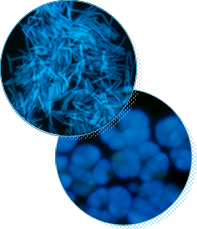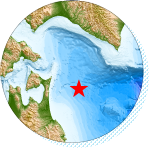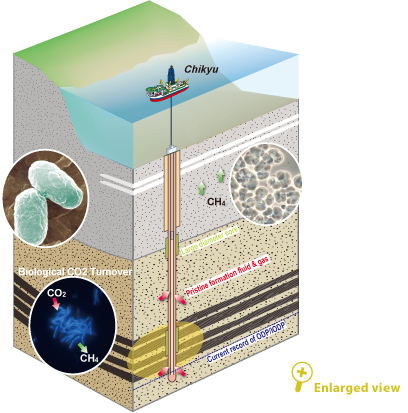Learn More about the Research Let’s ask the Co-Chief Scientist Dr. Inagaki
- Fumio Inagaki
- JAMSTEC Kochi Institute for Core Sample Research, Geomicrobiology Group & Submarine Resources Research Project, Geobio-Engineering and Technology Group, Group Leader Senior Scientist


After the construction of Chikyu, she launched her shakedown expeditions in 2005 and 2006, right at this sea area off Shimokita.
During the shakedown expedition, we tested sediment-core sampling from the seabed to 365 m below the seafloor. I was luckily involved in that opportunity and found tremendous amount of microbial cells in there.
How and why such abundant microbial life can live in deep sediment?
What are ecosystem roles in Earth's environment?
How deep microbial cells are living there?
There are many important scientific questions raised from the first drilling experience of Chikyu.
Pilot studies of subsurface structure in this area showed a widespread coal seam buried in the Pacific Ocean from southern Hokkaido to Tohoku area in Japan.
The deep coalbeds are supposed to be 50 million years-old or more. Some parts of these coalbeds have not been fully matured yet, called as lignite (brown coal) or bituminous coal, which posse lower resource values and hence not worth industrially exploring so far. However, these lignite coals are still producing some nutrients and energy substrates in maturing process, which may support generation of natural gas (methane) and deep microbial life.
Because the coal was originally made of plants, we could say the deeply buried coalbed as "subseafloor forest", but we still don't know the deep life ecosystem in the "subseafloor forest" and if present, what is the ecological roles in deep carbon cycles--there is a natural gas and methane hydrates in relatively shallow marine sediment.
Another important characteristic in this area is the origin of sediment and rock formation.
As coals are derived from terrestrial plants, deep coal formation is ancient terrestrial deposit, perhaps 50 million-year old Eocene period.
We assume there is a terrestrial-marine transition zone at around 1600 meters below the seafloor, so called "unconformity layer", we will see marine sediment overlying the terrestrial coal formation.
Given such a dynamic sedimentary system, the drilling research will make it ideal for scientists to study the co-evolution of the geological formation history of the northwestern Pacific margin and the deep subseafloor biosphere that associates with "subseafloor forests".
Shipboard scientistic party of Expedition 337 is an international team, covering a broad range of scientific expertise, specialized in geology, physical property specialist, paleontology, sedimentology, resource geology, organic and inorganic geochemistry, microbiology and molecular ecology.
We will analyze cored materials, fluids and gas samples obtained by riser drilling. For example, after core recovery, samples are immediately scanned by a shipboard medial X-ray CT scanner to analyze internal structures.
This nondestructive testing will allow us to know what types of samples we have obtained and where some invisible specific events are placed in the retrieved core, highly useful for the subsequent sub-sampling and analyses.
Using these samples, we will study chemical composition of gas, fluid and solid sedimentary minerals, including organic matter like coals. For the deep life component, we will use a computer image-based life detection and enumeration technique that has been developed by my laboratory.
During Expedition 337, we will also extract environmental DNA directly from the obtained samples and analyze some important microbial genes related to taxonomic identification and biological carbon cycles.
This onboard molecular program will provide us a "fingerprint" of the deep biosphere and microbial metabolic functions. In addition, using chemical tracers, we will incubate some samples under in-situ condition (e.g., ~55 degree C, 400 pressure bar) and detect microbial activities that may contribute to the degradation of organic matter and production of bio-gas. So far, the world deepest record of subseafloor life detection is 1,626 m below the seafloor.
In this expedition, we will drill down to 2,200 m at least, so will expand our knowledge of the limit of deep biosphere.
It will be full of challenges! In terms of technological challenge, there will be 2 major target points during Expedition 337.
Challenge to drill down to 2,200 m below the seafloor by a Chikyu riser-drilling system and to get high-quality scientific samples from the deeply buried coal formation. This will be the deepest penetration-depth record in a half-century of scientific ocean drilling history.
Challenge to get deep formation fluids using a new borehole wire-line instrument in situ. We try to obtain a few hundreds milliliter of fluids from the deep seated coal-sand formation and bring it back to Chikyu under the in-situ pressure condition.
If succeeded, it will be highly valuable for many onboard geochemical and microbiological analyses and significantly expand our knowledge of the nature of deep biosphere and coalbed-hydrocarbon system.
In addition, making this expedition safe with successful operations of the ship crews and drilling team will be of our biggest challenging goals, of course.


















